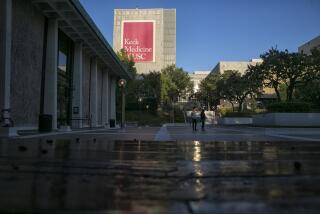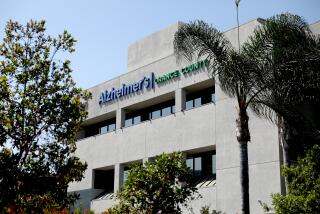18-Year-Old Research Scientist at UCLA : Youth Looks for Clues to Illness of Aging
- Share via
A scientist leaned over his microscope at the UCLA Brain Research Institute, carefully scanning cell clusters extracted from rat brains and grown in a plastic dish, looking for any that had died. He hopes to find the cause of Alzheimer’s disease, a devastating deterioration of the brain that kills or mentally cripples hundreds of thousands of aging Americans each year.
The scientist, James Nieh, is 18 years old. He was graduated from Saugus High School just last month.
This is the second summer Nieh has spent at the Brain Research Institute under the tutelage of Dr. M. Anthony Verity, chief of the division of neuropathology, doing research that Verity said is good enough to be published in a scientific journal.
“He thinks on a different plane from most people his age,” Verity said.
No one who knows Nieh seems to disagree. His closest friend, Chris Brown, said Nieh also has nearly boundless energy. “I know a lot of people who have an intuitive ability in a lot of things,” Brown said. “But with James, no matter how difficult something is, he’ll spend whatever time is needed to master it.”
Seeking Link to Aluminum
Nieh’s work at UCLA, which is focusing on the possible link between Alzheimer’s and traces of aluminum found in the brains of some victims, came from the same energy that has already made him a star debater, co-valedictorian, national science competition winner, choral singer and aspiring artist.
Nieh, who was born in Taiwan, was brought to Canada and then North Hollywood and Saugus by his mother, Jeanne Mosgrove. He took her maiden name. His next stop will be Harvard University, which he will enter in the fall as a freshman.
Nieh won the chance to study at UCLA last year after competing in the Junior Science and Humanities Symposium, which is sponsored in Southern California and Nevada by the California Museum of Science and Industry.
This May, he won first place in the symposium’s national competition, which was held at North Carolina State University, with a presentation titled “The Neurotoxicology of Al in Synaptosomes and Cerebellar Granule Cell Culture.”
At the end of July, Nieh will fly to London to represent the United States at an international version of the competition. Such trips are the closest thing he has had to vacations. Even his last Christmas break was spent at UCLA, studying brain tissue.
When describing his background, he had to refer several times to a four-page resume that he pulled from an overstuffed folder bearing the fading blue logo “Saugus Centurions.”
One of his findings, that aluminum does not reduce levels of an important brain chemical, contradicts a study done by a British biologist. When asked if he had communicated his conflicting results to the other scientist, Nieh said--in a rare moment of insecurity--that he wouldn’t have been taken seriously. “I’m just a high school student and he’s a big research scientist at Queen’s Hospital in London,” he said.
Above all, Nieh wants to be taken seriously. “Each individual born on Earth has to make some contribution,” he said. “Science is a fascinating way to do that. I want to leave something--some idea--behind.”
In a conference room at the Brain Research Institute, Nieh examined a half-inch-thick section of human brain, pickled in preservative and sealed in a plastic bag, that had been pulled from a wooden box full of dozens of similar slices. The gray, rubbery tissue displayed the abnormalities that can appear when Alzheimer’s strikes, causing memory loss and incapacitation.
The convoluted surface of the cortex was shrunken. The ventricles, two hollow areas that run front to back deep in the brain, were enlarged.
Brain Deformities Vary
Just one of the lingering mysteries of Alzheimer’s disease is that the brains of severely affected patients do not always develop these deformities, said Verity.
The place where abnormalities always occur, and where Nieh is focusing his attention, is at the level of individual cells within that mass of tissue. The classic signs of the disease include the presence of chaotic tangles of nerve fibers in the brains of victims. Recently, high concentrations of aluminum were detected in some of these tangles.
Nieh is studying the effect of aluminum on two types of brain cells: the nerve cells, or neurons, that sense, process and transmit signals, and glial cells, which nourish the neurons and provide a structural framework that supports these delicately branching cells.
Nieh works with cells isolated from the brains of newborn rats. These young growing cells can tolerate the rigors of life in a laboratory dish.
Plastic trays pocked with small wells hold living clumps of brain tissue; some are exposed to low concentrations of aluminum while others, included as a control, are raised under normal conditions.
Findings Provide Model
Even if aluminum does not turn out to be the cause of Alzheimer’s--and current research is leading in other directions--the toxic effect of aluminum on brain tissue provides a valuable model of some of the things that happen in a brain attacked by Alzheimer’s, Verity said.
Besides learning firsthand about the care and feeding of neurons, Nieh said, he has learned about a more mundane, but indispensable aspect of science: chasing scarce sources of funding.
His first effort came last year, when he sent a request for a research grant to the Henry Mayo Newhall Foundation in Valencia. He wanted $800 to cover the cost of a new microscope and $300 to cover expenses incurred while he studied at UCLA over his Christmas vacation, Nieh said.
The foundation had no fund for supporting such projects, but, a spokeswoman said, Nieh’s application convinced the organization to establish a research and education fund a few months later. The first grant went to Nieh.
Last week, he drafted a three-page letter that he sent to corporations around California, requesting $2,000 to get him through this last summer before he heads off to college. He set up a bank account under the title, “James Nieh Fund.” A contribution of $250 is in the works, he said.
To Concentrate on Physics
Despite Nieh’s recent preoccupation with neurobiology, he plans to concentrate in physics at Harvard. Biological research can be tedious and is fraught with setbacks and failures, he said. But his main reason for looking elsewhere is philosophical, not practical. It’s the lack of “precision and predictability” built into the life sciences that he finds limiting, he said.
“Biologists always kill me when I say this,” Nieh said. “Physics is a more precise science. It’s directly related to mathematics. Biology, even in its origins hundreds of years ago, was qualitative.
“Mathematics is imposed on biology,” he said, while it is inherent in physics.
Even in pursuing his avocations, Nieh’s plans are precise and his drive relentless. He wants to nurture a talent for drawing while at UCLA this summer. “I’m trying to take a class here,” he said. “It’s full, but I’m going to try and get in anyway.”






